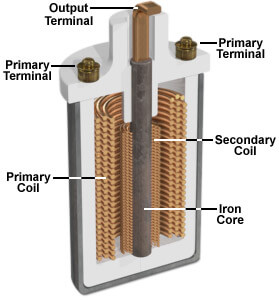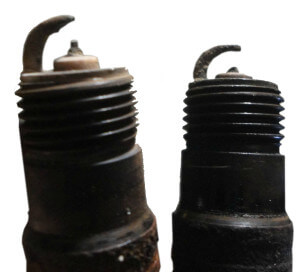Is it the ignition coil?
Is a bad ignition coil causing your misfire or no-start condition?
An ignition coil failure can be permanent, causing a no spark no start condition or it can intermittent, causing a cylinder-specific misfire condition or a random misfire. The trouble code for a random misfire condition is a P0300 and a cylinder specific misfire trouble code is P030X, with the X corresponding to the cylinder number.
Ignition coils are made in various configurations like: single can coil, coil pack and coil-on-plug (COP).
But they all operate on the same principle. They all include two coils, or “windings” of copper wire and an iron core. An ignition coil is a basically an electro-magnet like the kind you made in school by winding wire around a nail and connecting it to a battery. The only difference is that ignition coils have two sets of windings.
Ignition coil primary and secondary windings
The secondary winding coil is made from thousands of turns of thin copper wire that has been dipped in an enamel insulating coating. The primary winding coil is made from several  hundred turns of a much thicker wire. A typical ignition coil may have a ratio of 80:1 between the number of windings on the secondary versus the primary coil. The higher the ratio, the higher the spark voltage generated when current flow is shut off to the primary winding.
hundred turns of a much thicker wire. A typical ignition coil may have a ratio of 80:1 between the number of windings on the secondary versus the primary coil. The higher the ratio, the higher the spark voltage generated when current flow is shut off to the primary winding.
How an ignition coil works.
Battery power (12V) is supplied at high amperage (around 10-amps) to one end of the primary winding wrapped around the iron core. The other end is connect to ground to complete the circuit. The current flow is turned on and off on to the primary windings from the ground side of the circuit, by a free-standing ignition control module or the ignition circuitry in the PCM. As the current flows, it builds a magnetic field that envelops the iron core. It takes about 10-15 milliseconds for the magnetic field to build to maximum strength. This “build” time is referred to as “dwell.” At this point you have an electro-magnet.
When you turn off the current flow, the magnetic field collapses and the stored energy induces a current into the secondary windings. Depending on the ratio of windings between the primary and secondary coils, the voltage is multiplied by 80 to 100 times. So a primary coil with an 80:1 ratio and 200 windings would have almost 16,000 windings in the secondary coil. As the 12-volt 10-amp primary magnetic field collapses, the current transforms into around 50,000-volts.
How the ignition coil fires the spark plug
Depending on the type of ignition system, the high voltage travels to the spark plug via a spark plug wire, or directly from the ignition coil. The voltage flows down the core of the spark plug to the center electrode. However, it stops there because the cylinder’s air and fuel acts as a dielectric insulator, preventing the voltage from jumping the gap.  As the voltage on the center electrode builds, the air/fuel mixture becomes ionized, slowly becoming a conductor. Depending on the air/fuel mixture ratio, the compression ratio of the engine, and the spark plug gap the ionization completes somewhere around 12,000 to 25,000 volts, although in high voltage large gap designs, this can occur around 45,000-volts.
As the voltage on the center electrode builds, the air/fuel mixture becomes ionized, slowly becoming a conductor. Depending on the air/fuel mixture ratio, the compression ratio of the engine, and the spark plug gap the ionization completes somewhere around 12,000 to 25,000 volts, although in high voltage large gap designs, this can occur around 45,000-volts.
Engineers may choose a larger gap and higher secondary voltage to obtain a hotter spark that last longer to ignite a leaner mixture. Or, they may opt for a smaller gap and lower voltage to ignite a rich mixture in a pre-ignition chamber, which in turn ignites the larger leaner mixture in the main combustion chamber.
What causes ignition coil failure?
The primary and secondary windings are separated from one another by the enamel coating and some type of dielectric insulating compound. In some cases the insulation is dielectric epoxy or a liquid dielectric. If the dielectric fails, the collapsing magnetic field will choose the path of least resistance and flow directly to ground inside the ignition coil, causing the spark plug not to fire or fire with too little heat.
If there’s only one ignition coil in the system and dielectric deterioration has proceeded to the point of a permanent failure, the coil won’t fire the spark plugs at all and you’ll have a no-spark, no start condition. If one coil within a coil pack fails, you’ll have a misfire on two cylinders. If a single COP style ignition coil fails, you’ll have a single cylinder misfire.
What causes ignition coil dielectric breakdown?
The No. 1 cause is excessive spark plug gap wear and worn spark plug wires. Keep in mind that at ignition you’ve got close to 45,000 volts ready to jump the gap. If
the insulation on the spark plug wire has deteriorated, the spark would much rather jump through the insulation and complete the circuit at the nearest portion of the engine—ambient air has less resistance than a compressed air/fuel mixture inside the cylinder. What causes spark plug wire insulation to fail? Two things: excessive spark plug gap and oil and coolant contamination on the insulation.
When to change spark plugs and spark plug wires?
High voltage travels from the ignition coil through the spark plug wires on its way to the spark plug. Over time the center conductor of that wire deteriorates causing gaps and high resistance. Open portions and high resistance can cause insulation fire-through.
What most drivers don’t understand is that a spark plug that’s rated for 100,000 miles is 80% worn at 80,000 miles. That’s the point where the spark plug gap begins to widen, creating more resistance to the ignition surge. That wider gap can cause spark plug wires to fail and misfire. That’s why it’s never good practice to exceed manufacturer’s recommendations for spark plug and spark plug wire replacement. Always replace spark plugs and spark plug wires slightly before their recommended change intervals.
A bad ignition coil can cause control module and PCM failure
An internal breakdown of the dielectric compound inside the ignition coil can also cause extensive damage to a free-standing ignition control module or the ignition control portion inside the PCM. These modules are built with sensitive switching electronics that are only designed to turn 12-volt 10-amp power on and off to the ignition coil. They can’t handle a backwards flow of 45,000 volts.
If your ignition control module fails, chances are you’ve got other ignition related issues that caused it to fail. If you don’t evaluate the entire ignition system, from spark plugs to spark plug wires, your replacement ignition control module or PCM may fail again.
How to test an ignition coil
WARNING: Never remove a spark plug wire from a spark plug or disconnect a spark plug wire from a coil pack while the engine is running. That technique was commonly used in older non-computerized engines, but it’s NOT ok to use it on a modern vehicle. Pulling a spark plug wire from a running engine is the single best way to damage an ignition coil, ignition control module or PCM.
Instead, use an ohmeter to check the coils primary and second resistance readings. Refer to a shop manual to locate the test terminals and obtain factory recommended specifications.
Don’t condemn an ignition coil simple because you have a misfire code
Misfires can be caused by a bad ignition coil, spark plug wire, spark plug, OR a fuel mixture issue, vacuum leak or mechanical problem.
©, 2017 Rick Muscoplat
Posted on by Rick Muscoplat


